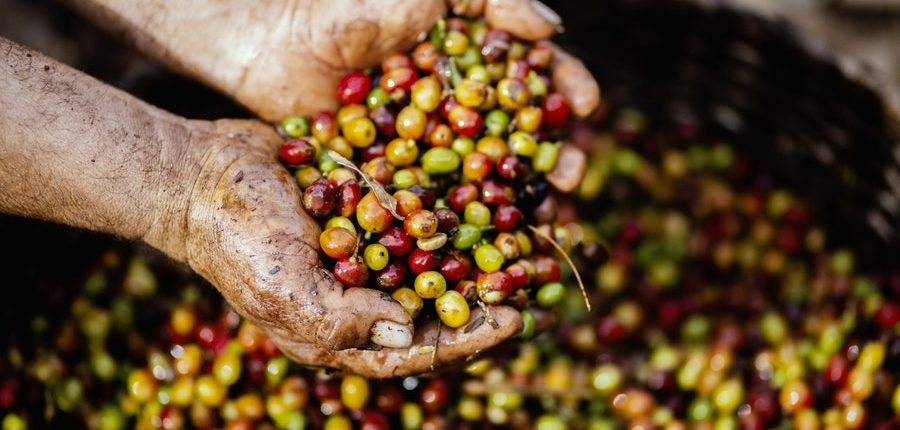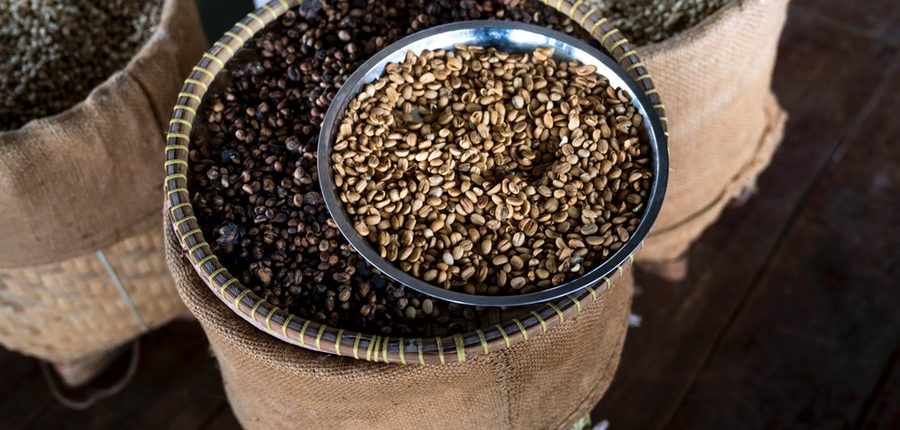Wet coffee processing is the most common and most popular type of processing throughout the coffee industry. And for good reason. Washed coffee
- is clean
- brings out the true flavors of the respective coffee type
- contains good caffeic acid.
So if you happen to read “washed coffee” in a café or on packaging: give it a try!
Content
- Definition and Terminology
- Wet vs Dry Processing
- The Taste of Washed Coffee
- Wet Processing − Step by Step
- Grading
- Pulping
- Fermentation
- Drying
- Criticism
Definition and Terminology
What is coffee preparation? The word “processed” nowadays has a negative ring to it. Especially when it comes to the food industry. We associate processing with chemicals, ready meals or factories. However, none of this applies to coffee processing.
Coffee beans are the seeds of a small red fruit known as the coffee cherry. Inside each coffee cherry there are two coffee beans. (Unless it is a pearl bean. In this case the seeds have not separated and instead you get one big round coffee bean.)
In order to be able to prepare a cup of coffee you first need to harvest the ripe coffee cherries. Next, you extract the seeds from the fruit. This is easier said than done. Because each coffee fruit consists of different layers:
- Exokarp: the outer layer or berry skin
- Mesokarp: the mucous layer is a silky, sticky layer that is responsible for the coffee’s sweetness
- Endokarp: the parchment layer
- Silberhaut: a membrane that surrounds the seeds
Processing coffee basically stands for removing all these layers from the coffee beans. As a matter of fact, there are several possibilities to do so. These include, for instance, wet processing and dry processing. Each type of processing has an individual influence on your coffee’s taste profile.
Wet vs. Dry Coffee Processing
Between coffee harvesting and storage/export there are two things that should happen to coffee cherries: On one hand, the pulp has to be removed from the coffee beans. On the other hand, the beans are being properly dried. The order in which these two processes take place determines the fundamental difference between different types of coffee processing.
- With fully washed coffee, at least some of the fruit layers are removed before starting the drying process. The terms “wet processing” and “washed coffee” stem from the fact that you use water for it. A lot. Traditionally, water is mainly used to wash off the mucilage. This happens once the coffee has fermented in the water for a while. Only then you can dry the coffee.
- With so-called unwashed or natural coffee, the pulp is only removed from the coffee beans after they have dried.
- In the case of honey or pulped natural processing, the berry skin and part of the mucous layer are removed from the coffee bean before drying. The rest is removed afterwards.
The Taste of Washed Coffee
Now it is time for the all-important question: What does washed coffee actually taste like? And why is wet-processed coffee often described as particularly “pure in taste”?
During wet coffee processing, the entire pulp is removed from the coffee bean before drying. This is why washed processing is the best method to emphasize the bean’s own flavor. In other words: if you choose wet-processed coffee you will taste the essence of coffee. Its origin, the coffee type, the terroir. That is to say that the full aroma of good coffee is far more complex than “just” the coffee preparation method. As a result, wet coffee processing is best suited to beans with an outstanding taste profile.
Washed processing can also result in good caffeic acids. Many lovers of speciality coffee appreciate this lively, fruity quality.
However, dry processed coffees often taste particularly fruity. The reason for this is that the mucous layer remains on the beans during drying. Over time, the fruit sugar and other components contained in it ferment. This fermentation process in turn affects the taste of the finished coffee. In this respect, dry-processed coffee differs drastically from washed coffee.
Natural and honey-processing coffees undergo a long fermentation process. For this reason, it is difficult to predict the final cup profile. Consequently, dry processed coffees require particularly strict quality control. However, with washed coffee, fermentation takes place at the very beginning. It is therefore easier to control. This is why washed coffees are particularly stable in terms of quality which makes them more reliable and, thus, attractive to trade with.
Wet Processing − Step by Step
In the meantime, we have learned that with wet coffee processing, the fruit is removed before drying. However, the entire process of this processing method contains complex details. So let us look at the procedure together:
1. Grading
After the coffee harvest, the producers of specialty coffee start to grade the coffee cherries. Coffee grading starts with the removal of any unripe or inferior cherries. To begin with, all the coffee cherries are placed in a container with water. The cherries that float on the surface are then being removed. This is because inferior cherries have poorly developed seeds between which air pockets form. High-quality coffee, in contrast, is denser than water and will therefore sink.

Although there are two different levels of quality, coffee farmers usually process both. However, they sell the coffees separately, at different prices, and in different markets.
2. Pulping
In the next stage of processing, the pulp or the skin of the coffee cherry is removed from the coffee beans. For this purpose you can use a machine called a “depulper”. At this point it is very important to check the coffee afterwards as the depulper does not remove the same quantity of pulp from all cherries.
3. Fermentation
Next, it is time to ferment the coffee beans. Traditionally, coffee is fermented in tanks. This process usually takes between 18 and 24 hours, depending on temperature and coffee quality. During this time, microorganisms in the beans develop enough enzymes to break down the mucous layer. There are also other methods of fermentation for coffee producers.
4. Drying
The last step is drying which takes about 6 days to 2 weeks depending on the processing method. It is a high-risk process because the coffee beans are now extremely susceptible to damage caused by microorganisms. There is also the risk of physical damage for example due to the weather.

Small coffee farmers often let the coffee dry in the sun while larger manufacturers usually use mechanical dryers. Some plantations also combine both methods. There, the coffee is sun-dried for the first two to three days. Afterwards it is dried mechanically. Thereby farmers achieve a very good coffee quality with lower energy consumption and costs.
Criticism
One of the biggest points of criticism against wet coffee processing is its high water consumption. This is a problem not only in areas where water is scarce. In fact, inadequate wastewater treatment can also lead to chemicals entering the local groundwater supply. For this reason, coffee associations and producers of coffee equipment invest in research: they want to achieve the effect of washed processing without the excessive water consumption.
The biggest challenge for the coffee industry is that coffee processing is “clean” and environmentally friendly. Fortunately, there are more and more technical possibilities and a growing awareness of the importance of sustainable agriculture.
